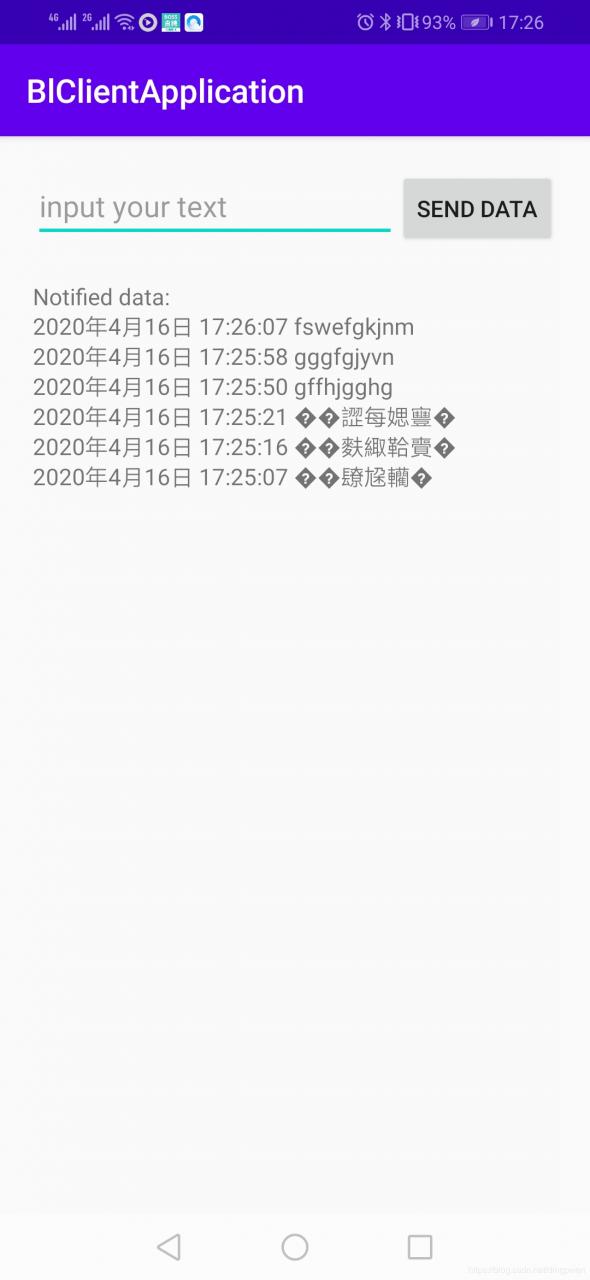Android Phone蓝牙通信方式总结(Socket与Gatt)
Android手机间通过蓝牙方式进行通信,有两种常见的方式,一种是socket方式,另一种是通过Gatt Server(Android 5.0以后)通信,socket方式最为简单,但是很多低功耗的蓝牙设备,如单片机上的蓝牙模块可能不支持。而Gatt方式说起来就比较复杂,我研究了好会儿,搜索了不少资料,走了不少弯路才总结出来。
首先来看比较简单的socket方式其实无论是socket方式还是Gatt,Android设备间蓝牙通信都是一种CS(client-server)模式。
1)socket服务端:
使用listenUsingInsecureRfcommWithServiceRecord接口开启监听,其他同一般的socket网络通信没区别:
init{
mSocket = mBleAdapter.listenUsingInsecureRfcommWithServiceRecord("GomeServer", Constants.BLE_SERVICE_UUID)
}
override fun run() {
var socket: BluetoothSocket?
try{
while(running) {
socket = mSocket.accept()
if(socket != null) {
val inputStream = socket.inputStream
val os = socket.outputStream
var read:Int
val byteArray = ByteArray(1024) { 0}
while(socket.isConnected) {
read = inputStream.read(byteArray)
if(read == -1) break
val byte = ByteArray(read){ byteArray[it] }
val message = Message.obtain()
message.obj = String(byte)
mHandler.sendMessage(message)
//Thread.sleep(2000)
break
}
os.close()
socket.close()
}
}
} catch(e:IOException) {
e.printStackTrace()
}
}
2)socket客户端
客户端对应的接口是createRfcommSocketToServiceRecord:
private void connectBleDeviceSocket(final BluetoothDevice device, final String content) {
if(sSocket != null) {
try {
sSocket.close();
} catch (IOException e) {
e.printStackTrace();
}
sSocket = null;
}
OutputStream out = null;
try {
sSocket = device.createRfcommSocketToServiceRecord(Constants.MY_SERVICE_UUID);
if(sSocket != null) {
sSocket.connect();
out = sSocket.getOutputStream();
out.write(content.getBytes());
Thread.sleep(100);
}
} catch (IOException | InterruptedException e) {
Log.e(TAG,"stack:", e);
} finally {
if(out != null) {
try {
out.close();
} catch (IOException e) {
e.printStackTrace();
}
}
if(sSocket != null) {
try {
sSocket.close();
} catch (IOException e) {
e.printStackTrace();
}
}
}
}
至于device可以直接通过mac获取:
BluetoothDevice device = mBleAdapter.getRemoteDevice(mac);
Android手机蓝牙通信socket方式最需要注意的是,SERVICE_UUID是固定的,必须是如下的定义:
public static final UUID MY_SERVICE_UUID = UUID.fromString("00001101-0000-1000-8000-00805F9B34FB");
至于socket方式的读写,跟一般网络通信没啥区别,这里就不描叙了。
2. Gatt方式
蓝牙Gatt方式相对来说比较复杂,稍微不按着它的流程来可能就行不通,这里慢慢看来。
1)Gatt服务端
首先我们需要启动一个Gattserver,同时我们还需要把用BluetoothLeAdvertiser它广播出去,这样客户端才能搜到。
Gattserver的定义:
private fun setupServer() {
val gattService = BluetoothGattService(Constants.BLE_SERVICE_UUID, BluetoothGattService.SERVICE_TYPE_PRIMARY)
val characteristicRead = BluetoothGattCharacteristic(Constants.BLE_READ_UUID, BluetoothGattCharacteristic.PROPERTY_READ, BluetoothGattCharacteristic.PERMISSION_READ)
val descriptor = BluetoothGattDescriptor(Constants.BLE_DESC_UUID, BluetoothGattCharacteristic.PERMISSION_WRITE)
characteristicRead.addDescriptor(descriptor)
gattService.addCharacteristic(characteristicRead)
val characteristicWrite = BluetoothGattCharacteristic(Constants.BLE_WRITE_UUID, BluetoothGattCharacteristic.PROPERTY_WRITE or
BluetoothGattCharacteristic.PROPERTY_READ or BluetoothGattCharacteristic.PROPERTY_NOTIFY,
BluetoothGattCharacteristic.PERMISSION_WRITE)
gattService.addCharacteristic(characteristicWrite)
Log.d("wenpd", "startGattServer:stagattServicetus=$gattService")
mGattServer.addService(gattService)
}
然后是广播的定义:
private fun startAdvertising() {
val settings = AdvertiseSettings.Builder()
.setAdvertiseMode(AdvertiseSettings.ADVERTISE_MODE_BALANCED)
.setTimeout(0)
.setConnectable(true)
.setTxPowerLevel(AdvertiseSettings.ADVERTISE_TX_POWER_LOW)
.build()
val advertiseData = AdvertiseData.Builder()
.setIncludeDeviceName(true)
.addServiceUuid(ParcelUuid(Constants.BLE_SERVICE_UUID))
.build()
/*val scanResponseData = AdvertiseData.Builder()
.addServiceUuid(ParcelUuid(Constants.BLE_SERVICE_UUID))
.setIncludeTxPowerLevel(true)
.build()*/
mAdvertiseCallback = object : AdvertiseCallback() {
override fun onStartSuccess(settingsInEffect: AdvertiseSettings) {
Log.d("wenpd", "BLE advertisement added successfully")
}
override fun onStartFailure(errorCode: Int) {
Log.e("wenpd", "Failed to add BLE advertisement, reason: $errorCode")
}
}
mBluetoothLeAdvertiser.startAdvertising(settings, advertiseData, mAdvertiseCallback)
}
我们在OnResume中启动server与广播:
override fun onResume() {
super.onResume()
if (mBleAdapter == null || !(mBleAdapter as BluetoothAdapter).isEnabled) {
val enableBtIntent = Intent(BluetoothAdapter.ACTION_REQUEST_ENABLE)
startActivity(enableBtIntent)
finish()
return
}
if (!packageManager.hasSystemFeature(PackageManager.FEATURE_BLUETOOTH_LE)) {
finish()
return
}
if(Constants.BLE_CONNECT_MODE == 1) {
if (!(mBleAdapter as BluetoothAdapter).isMultipleAdvertisementSupported) {
finish()
return
}
mBluetoothLeAdvertiser = (mBleAdapter as BluetoothAdapter).bluetoothLeAdvertiser
mGattServer = mBleManager?.openGattServer(this, gattServerCallback) as BluetoothGattServer
setupServer()
startAdvertising()
}
}
我们再看这里openGattServer(this, gattServerCallback) as BluetoothGattServer,gattServerCallback的定义:
private val gattServerCallback = object:BluetoothGattServerCallback() {
override fun onConnectionStateChange(device: BluetoothDevice?, status: Int, newState: Int) {
super.onConnectionStateChange(device, status, newState)
Log.d("wenpd", "onConnection:status=$status,newState=$newState")
if (newState == BluetoothProfile.STATE_CONNECTED) {
mDevices.add(device!!)
} else if (newState == BluetoothProfile.STATE_DISCONNECTED) {
mDevices.remove(device)
}
}
override fun onCharacteristicWriteRequest(device: BluetoothDevice?, requestId: Int, characteristic: BluetoothGattCharacteristic?, preparedWrite: Boolean, responseNeeded: Boolean, offset: Int, value: ByteArray?) {
super.onCharacteristicWriteRequest(device, requestId, characteristic, preparedWrite, responseNeeded, offset, value)
Log.d("wenpd", "onCharacteristicWrite:characteristic=${characteristic?.uuid},value=$value")
if (characteristic!!.uuid == Constants.BLE_WRITE_UUID) {
setReceivedData(String(value!!, StandardCharsets.UTF_8));
mGattServer.sendResponse(device, requestId, BluetoothGatt.GATT_SUCCESS, 0, null)
val length = value!!.size
val reversed = ByteArray(length)
for (i in 0 until length) {
reversed[i] = value[length - (i + 1)]
}
characteristic.value = reversed
for (dev in mDevices) {
mGattServer.notifyCharacteristicChanged(dev, characteristic, false)
}
}
}
客户端写数据会调用onCharacteristicWriteRequest,而onCharacteristicWriteRequest中,通过 mGattServer.notifyCharacteristicChanged(dev, characteristic, false)将信息反馈给客户端。
到此服务端就设置好了,注意:
val BLE_SERVICE_UUID = UUID.fromString("00001802-0000-1000-8000-00805f9b34fb")
val BLE_WRITE_UUID = UUID.fromString("00002a02-0000-1000-8000-00805f9b34fb")
这两个ID客户端是需要知道的。
2)Gatt客户端
Gatt客户端不能直接通过mac来获取device然后通信,我开始这样做,然后就出现如下困惑:
https://stackoverflow.com/questions/60859756/how-to-communicate-with-each-other-in-two-android-phones-through-bluetoothgatt
郁闷了好久。
Gatt客户端需要通过server UUID来搜索设备。
看搜索代码:
private void startScan() {
if (!hasPermissions() || mScanning) {
return;
}
Log.d(TAG, "startScan");
List filters = new ArrayList();
ScanFilter scanFilter = new ScanFilter.Builder()
.setServiceUuid(new ParcelUuid(Constants.SERVICE_UUID))
.build();
filters.add(scanFilter);
ScanSettings settings = new ScanSettings.Builder()
.setScanMode(ScanSettings.SCAN_MODE_LOW_POWER)
.build();
/*mScanResults = new HashMap();
mScanCallback = new BtleScanCallback(mScanResults);*/
mScanCallback = new BtleScanCallback();
mBluetoothLeScanner = mBluetoothAdapter.getBluetoothLeScanner();
mBluetoothLeScanner.startScan(filters, settings, mScanCallback);
mScanning = true;
mHandler = new Handler();
mHandler.postDelayed(new Runnable() {
@Override
public void run() {
stopScan();
}
}, SCAN_PERIOD);
}
注意,这里的Constants.SERVICE_UUID,与服务端是一致的。
搜到设备后就可以直接连接了:
private class BtleScanCallback extends ScanCallback {
/*private HashMap mScanResults;
private BtleScanCallback(HashMap scanResults) {
mScanResults = scanResults;
mScanResults.clear();
}*/
@Override
public void onScanResult(int callbackType, ScanResult result) {
addScanResult(result);
}
@Override
public void onBatchScanResults(List results) {
for (ScanResult result : results) {
addScanResult(result);
}
}
@Override
public void onScanFailed(int errorCode) {
Log.e(TAG, "BLE Scan Failed with code " + errorCode);
}
private void addScanResult(ScanResult result) {
Log.d(TAG, "addScanResult:" + result);
/*BluetoothDevice device = result.getDevice();
String deviceAddress = device.getAddress();
mScanResults.put(deviceAddress, device);*/
stopScan();
BluetoothDevice bluetoothDevice = result.getDevice();
connectDevice(bluetoothDevice);
}
}
private void connectDevice(BluetoothDevice device) {
GattClientCallback gattClientCallback = new GattClientCallback();
mGatt = device.connectGatt(this, false, gattClientCallback);
}
这里最重要就是BluetoothGattCallback了:
private class GattClientCallback extends BluetoothGattCallback {
@Override
public void onConnectionStateChange(BluetoothGatt gatt, int status, int newState) {
super.onConnectionStateChange(gatt, status, newState);
if (status == BluetoothGatt.GATT_FAILURE) {
disconnectGattServer();
return;
} else if (status != BluetoothGatt.GATT_SUCCESS) {
disconnectGattServer();
return;
}
if (newState == BluetoothProfile.STATE_CONNECTED) {
mConnected = true;
gatt.discoverServices();
} else if (newState == BluetoothProfile.STATE_DISCONNECTED) {
disconnectGattServer();
}
}
@Override
public void onServicesDiscovered(BluetoothGatt gatt, int status) {
super.onServicesDiscovered(gatt, status);
Log.d(TAG, "onServicesDiscovered status:" + status);
if (status != BluetoothGatt.GATT_SUCCESS) {
return;
}
BluetoothGattService service = gatt.getService(Constants.SERVICE_UUID);
BluetoothGattCharacteristic characteristic = service.getCharacteristic(Constants.CHARACTERISTIC_UUID);
characteristic.setWriteType(BluetoothGattCharacteristic.WRITE_TYPE_DEFAULT);
mInitialized = gatt.setCharacteristicNotification(characteristic, true);
}
@Override
public void onCharacteristicChanged(BluetoothGatt gatt, BluetoothGattCharacteristic characteristic) {
super.onCharacteristicChanged(gatt, characteristic);
byte[] messageBytes = characteristic.getValue();
/*for(int i = 0, j = messageBytes.length -1; i < j; ++i, --j) {
byte temp = messageBytes[i];
messageBytes[i] = messageBytes[j];
messageBytes[j] = temp;
}*/
String messageString = new String(messageBytes, StandardCharsets.UTF_8);
Log.d(TAG,"Received message: " + messageString);
setReceivedData(messageString);
}
}
重点需要注意onServicesDiscovered中对service和character的设置代码:
BluetoothGattService service = gatt.getService(Constants.SERVICE_UUID);
BluetoothGattCharacteristic characteristic = service.getCharacteristic(Constants.CHARACTERISTIC_UUID);
characteristic.setWriteType(BluetoothGattCharacteristic.WRITE_TYPE_DEFAULT);
mInitialized = gatt.setCharacteristicNotification(characteristic, true);
只有这里设置好了,客户端才能向服务器发送数据。onCharacteristicChanged是收到来自服务端的反馈数据。
这一切配置好后,发送数据就简单了:
private void sendMessage() {
if (!mConnected || !mInitialized) {
return;
}
EditText messageEditText = findViewById(R.id.data);
BluetoothGattService service = mGatt.getService(Constants.SERVICE_UUID);
BluetoothGattCharacteristic characteristic = service.getCharacteristic(Constants.CHARACTERISTIC_UUID);
String message = messageEditText.getText().toString();
if(message.isEmpty()) {
return;
}
messageEditText.setText("");
byte[] messageBytes = message.getBytes(StandardCharsets.UTF_8);
characteristic.setValue(messageBytes);
boolean success = mGatt.writeCharacteristic(characteristic);
Log.d(TAG, "send message success:" + success);
}
注意蓝牙每次发送最大字节数为20,超过20,网上去搜别人怎么做的。
看结果:


其他部分代码,可参考:
https://github.com/dingpwen/bl_communication
GATT 使用的详细流程可参考网址:
https://nerdranchighq.wpengine.com/blog/bluetooth-low-energy-on-android-part-1/
https://nerdranchighq.wpengine.com/blog/bluetooth-low-energy-on-android-part-2/
作者:dingpwen